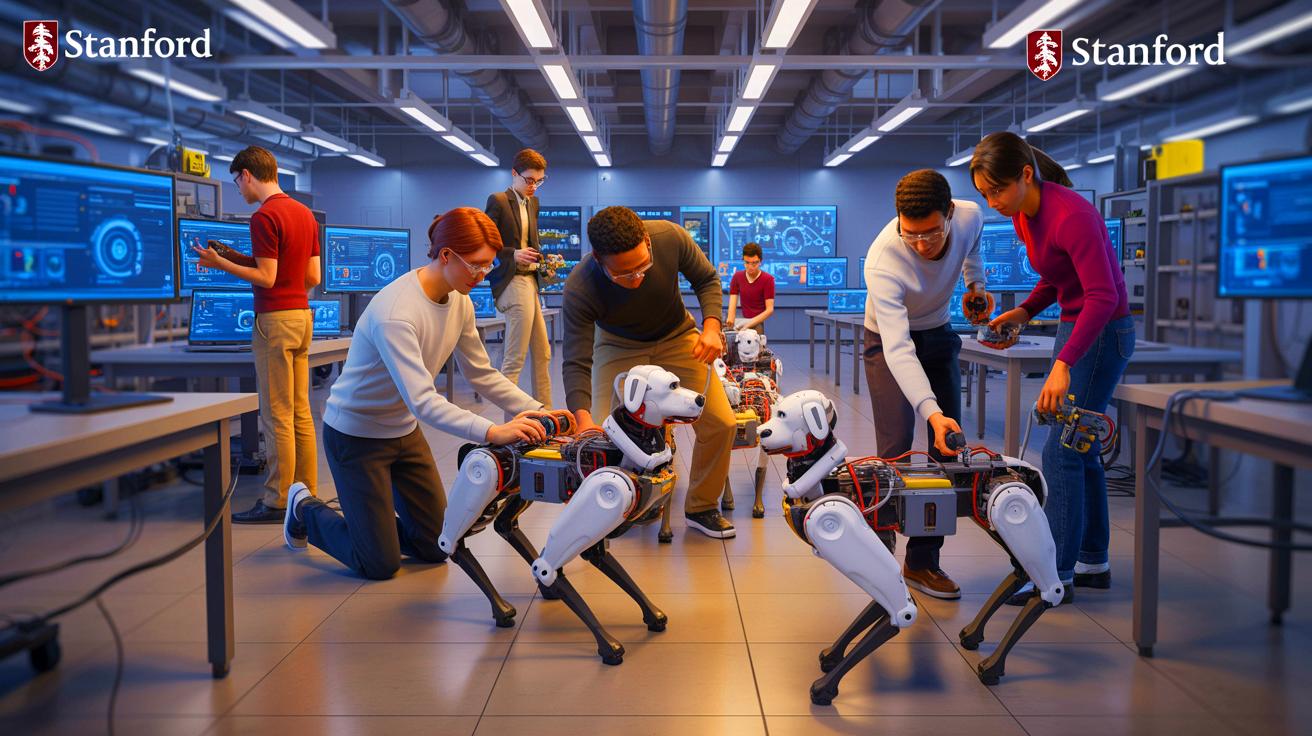In a stunning showcase of innovation and hands on engineering, a group of bright students from Stanford University has taken the tech world by storm by building a mini AI robot dog from scratch. Unlike commercial models that rely heavily on corporate funding and pre built modules, this DIY marvel is a true testimony to creativity, perseverance, and the power of learning by doing. Experts have hailed this project as a breakthrough in educational robotics, a field that is rapidly transforming how we perceive engineering education and artificial intelligence.
The Birth of a Mini AI Robot Dog: From Dorm Room to Lab Genius
The project began humbly in the dorm rooms of Stanford’s Computer Science and Mechanical Engineering departments. Inspired by Boston Dynamics’ Spot and driven by the desire to make robotics more accessible, the students set out to build a mini AI robot dog using open source tools, 3D printing, and repurposed electronics.
Personal experience from lead student Emily Zhang gives insight into their journey. “We wanted to build something that didn’t just function but learned and adapted like a real dog. It wasn’t just about mimicking motion it was about instilling real AI behavior in a compact, affordable unit.”
Using Raspberry Pi 5, Python based neural networks, and off the shelf servo motors, they created a compact quadruped that could walk, navigate, respond to voice commands, and even display primitive emotional responses using facial LEDs and behavioral cues.
Why Experts Are Calling It a Game Changer in Educational Robotics
Industry veterans have been quick to recognize the value of this student built innovation. Dr. Amanda Lee, a senior AI robotics engineer at NVIDIA, commented. “What makes this mini AI robot dog remarkable is not just its functionality, but the fact that it was made entirely by students with minimal funding. It changes the narrative of who can build intelligent machines.”
From a technical standpoint, the robot uses computer vision powered by TensorFlow Lite, enabling it to identify objects, avoid obstacles, and follow its human handler. The AI module is trained using reinforcement learning models to improve over time, giving the robot adaptive behavior that surprises even seasoned engineers.
The DIY Model vs. Commercial AI Robots
When compared side by side with commercial robots like Unitree Go1 or Sony’s Aibo, the Stanford built mini AI robot dog held its ground in essential capabilities despite being only a fraction of the cost.
Lessons in Engineering and Human Centric Design
This isn’t just a story about tech it’s about human potential. These Stanford students didn’t just build a mini AI robot dog; they designed a learning companion, a potential therapy tool for the elderly, and a low cost educational kit for underfunded schools.
Professor Miguel Alvarez, who supervised the project, shared his insight. “This robot reflects what’s possible when students are given space to explore. It’s engineering grounded in empathy technology with a purpose.”
Their robot includes modular parts that can be easily swapped or upgraded, meaning schools could use the blueprint for student workshops in robotics, AI, and design thinking. This approach bridges the gap between theoretical learning and practical impact.
Future Implications of DIY Robotics Projects
With open source files being prepared for release on GitHub, the mini AI robot dog could soon become a global educational phenomenon. Already, institutions in India, Kenya, and Brazil have reached out to collaborate on localized versions of the design.
Moreover! the team is now working on voice based emotional recognition enabling the robot dog to sense sadness or excitement in a user’s tone and respond accordingly. This type of emotionally intelligent AI, built on a budget, could revolutionize accessibility in robotics. As more people replicate and build upon this work, the barriers to entry in advanced robotics could be shattered forever.
Building the Future One Bolt at a Time
In a world where most of us expect the next big innovation to come from multi billion dollar tech giants, these Stanford students have reminded us of the enduring power of DIY engineering and curiosity. Their journey was not just about building a mini AI robot dog, but about building a culture of accessible innovation, where knowledge is open, creativity is encouraged, and anyone can be an inventor.
As this story gains global attention, it’s clear that this little robot dog is more than a mechanical pet it’s a symbol of a brighter, more inclusive future in robotics.
This Stanford born mini AI robot dog is a beacon of how far passion and collaboration can take us. It’s a clear example of how the intersection of education, AI, and hardware design can create impactful solutions. Whether it’s used in classrooms, therapy centers, or research labs, its influence will ripple far beyond the university walls. As student engineer Marcus Lim puts it. “We didn’t just build a robot. We built a movement.”


1 thought on “Stanford’s Mini AI Robot Dog Shocks Experts: Game Changing DIY Invention Redefines Student Robotics”